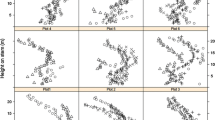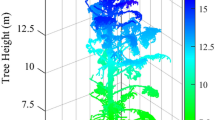Abstract
Forest inventory parameters, primarily tree diameter and height, are required for several management and planning activities. Currently, Terrestrial Laser Scanning (TLS) is a promising technology in automated measurements of tree parameters using dense 3D point clouds. In comparison with conventional manual field inventory methods, TLS systems would supplement field data with detailed and relatively higher degree of accurate measurements and increased measurement frequency. Although, multiple scans from TLS captures more area, they are resource and time consuming to ensure proper co-registration between the scans. On the other hand, Single scans provide a fast and recording of the data but are often affected by occlusions between the trees. The current study evaluates potential of single scan TLS data to (1) develop an automatic method for tree stem identification and diameter estimation (diameter at breast height—DBH) using random sample consensus (RANSAC) based circle fitting algorithm, (2) validate using field based measurements to derive accuracy estimates and (3) assess the influence of distance to scanner on detection and measurement accuracies. Tree detection and diameter measurements were validated for 5 circular plots of 20 m radius using single scans in dry deciduous forests of Betul, Madhya Pradesh. An overall tree detection accuracy of 85 and 70% was observed in the scanner range of 15 and 20 m respectively. The tree detection accuracies decreased with increased distance to the scanner due to the decrease in visible area. Also, estimated stem diameter using TLS was found to be in agreement with the field measured diameter (R2 = 0.97). The RMSE of estimated DBH was found to be 3.5 cm (relative RMSE ~20%) over 202 trees detected over 5 plots. Results suggest that single scan approach suffices the cause of accuracy, reducing uncertainty and adds to increased sampling frequency in forest inventory and also implies that TLS has a seemingly high potential in forest management.



Similar content being viewed by others
References
Aschoff, T., & Spiecker, H. (2004). Algorithms for the automatic detection of trees in laser scanner data. International Archives of Photogrammetry, Remote Sensing and Spatial Information Sciences, 36(Part 8), W2.
Bauwens, S., Bartholomeus, H., Calders, K., & Lejeune, P. (2016). Forest inventory with terrestrial LiDAR: A comparison of static and hand-held mobile laser scanning. Forests, 7(6), 127.
Bienert, A., Scheller, S., Keane, E., Mohan, F., & Nugent, C. (2007). Tree detection and diameter estimations by analysis of forest terrestrial laserscanner point clouds. In ISPRS workshop on laser scanning (Vol. 2007, pp. 50–55).
Chum, O. (2005). Two-view geometry estimation by random sample and consensus. Prague: Czech Technical University.
Fischler, M. A., & Bolles, R. C. (1981). Random sample consensus: a paradigm for model fitting with applications to image analysis and automated cartography. Communications of the ACM, 24(6), 381–395.
Haala, N., Reulke, R., Thies, M., & Aschoff, T. (2004). Combination of terrestrial laser scanning with high resolution panoramic images for investigations in forest applications and tree species recognition. International Archives of Photogrammetry, Remote Sensing and Spatial Information Sciences, 34(5/W16).
Hackenberg, J., Spiecker, H., Calders, K., Disney, M., & Raumonen, P. (2015). SimpleTree—An efficient open source tool to build tree models from TLS clouds. Forests, 6(11), 4245–4294.
Huang, H., Li, Z., Gong, P., Cheng, X., Clinton, N., Cao, C., et al. (2011). Automated methods for measuring DBH and tree heights with a commercial scanning lidar. Photogrammetric Engineering & Remote Sensing, 77(3), 219–227.
Liang, X., Litkey, P., Hyyppa, J., Kaartinen, H., Vastaranta, M., & Holopainen, M. (2012). Automatic stem mapping using single-scan terrestrial laser scanning. IEEE Transactions on Geoscience and Remote Sensing, 50(2), 661–670.
Lovell, J. L., Jupp, D. L. B., Newnham, G. J., & Culvenor, D. S. (2011). Measuring tree stem diameters using intensity profiles from ground-based scanning lidar from a fixed viewpoint. ISPRS Journal of Photogrammetry and Remote Sensing, 66(1), 46–55.
Maas, H.-G., Bienert, A., Scheller, S., & Keane, E. (2008). Automatic forest inventory parameter determination from terrestrial laser scanner data. International Journal of Remote Sensing, 29(5), 1579–1593.
Meng, X., Currit, N., & Zhao, K. (2010). Ground filtering algorithms for airborne LiDAR data: A review of critical issues. Remote Sensing, 2(3), 833–860.
Newnham, G. J., Armston, J. D., Calders, K., Disney, M. I., Lovell, J. L., Schaaf, C. B., et al. (2015). Terrestrial laser scanning for plot-scale forest measurement. Current Forestry Reports, 1(4), 239–251.
Nölke, N., Fehrmann, L., I Nengah, S. J., Tiryana, T., Seidel, D., & Kleinn, C. (2015). On the geometry and allometry of big-buttressed trees-a challenge for forest monitoring: new insights from 3D-modeling with terrestrial laser scanning. iForest-Biogeosciences and Forestry, 681.
Olofsson, K., Holmgren, J., & Olsson, H. (2014). Tree stem and height measurements using terrestrial laser scanning and the RANSAC algorithm. Remote Sensing, 6(5), 4323–4344.
Simonse, M., Aschoff, T., Spiecker, H., & Thies, M. (2003). Automatic determination of forest inventory parameters using terrestrial laser scanning. In Proceedings of the scandlaser scientific workshop on airborne laser scanning of forests (Vol. 2003, pp. 252–258).
Thies, M., & Spiecker, H. (2004). Evaluation and future prospects of terrestrial laser scanning for standardized forest inventories. Forest, 2(2.2), 1.
Xu, W., Su, Z., Feng, Z., Xu, H., Jiao, Y., & Yan, F. (2013). Comparison of conventional measurement and LiDAR-based measurement for crown structures. Computers and Electronics in Agriculture, 98, 242–251.
Zheng, G., Moskal, L. M., & Kim, S.-H. (2013). Retrieval of effective leaf area index in heterogeneous forests with terrestrial laser scanning. IEEE Transactions on Geoscience and Remote Sensing, 51(2), 777–786.
Acknowledgements
We duly acknowledge the funding by Indian Space Research Organisation—Geosphere Biosphere Program (ISRO—GBP) for the current study.
Author information
Authors and Affiliations
Corresponding author
About this article
Cite this article
Reddy, R.S., Jha, C.S. & Rajan, K.S. Automatic Tree Identification and Diameter Estimation Using Single Scan Terrestrial Laser Scanner Data in Central Indian Forests. J Indian Soc Remote Sens 46, 937–943 (2018). https://doi.org/10.1007/s12524-018-0753-7
Received:
Accepted:
Published:
Issue Date:
DOI: https://doi.org/10.1007/s12524-018-0753-7




